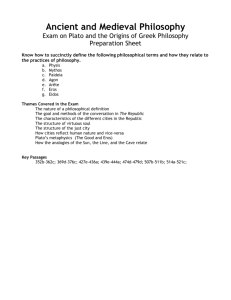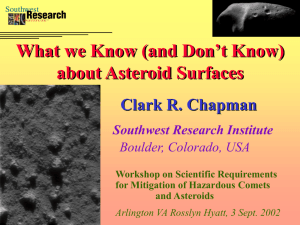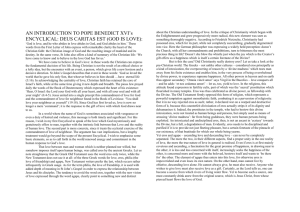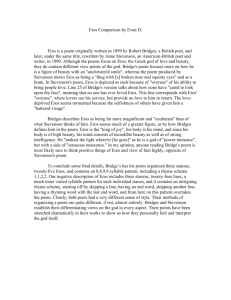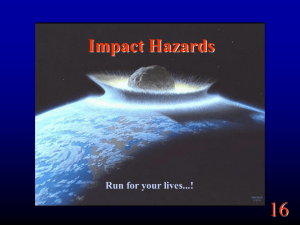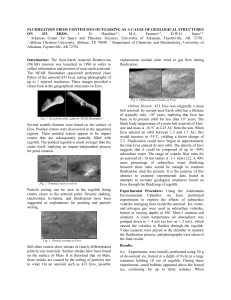What we Know and Don't Know about Asteroid Surfaces
advertisement
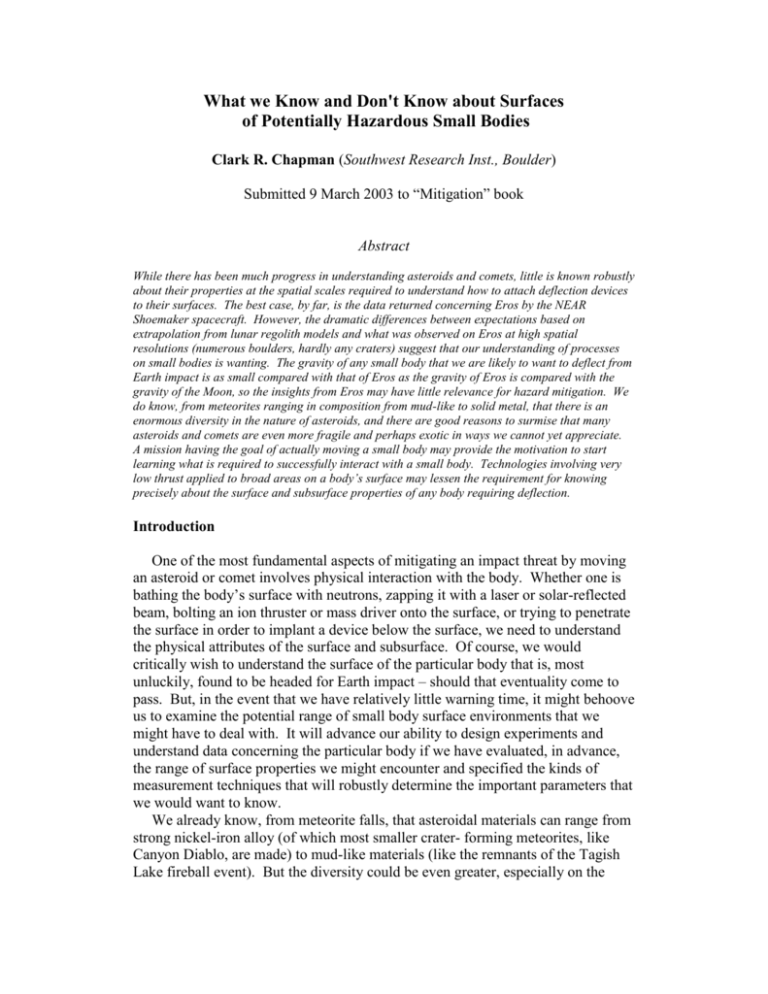
What we Know and Don't Know about Surfaces of Potentially Hazardous Small Bodies Clark R. Chapman (Southwest Research Inst., Boulder) Submitted 9 March 2003 to “Mitigation” book Abstract While there has been much progress in understanding asteroids and comets, little is known robustly about their properties at the spatial scales required to understand how to attach deflection devices to their surfaces. The best case, by far, is the data returned concerning Eros by the NEAR Shoemaker spacecraft. However, the dramatic differences between expectations based on extrapolation from lunar regolith models and what was observed on Eros at high spatial resolutions (numerous boulders, hardly any craters) suggest that our understanding of processes on small bodies is wanting. The gravity of any small body that we are likely to want to deflect from Earth impact is as small compared with that of Eros as the gravity of Eros is compared with the gravity of the Moon, so the insights from Eros may have little relevance for hazard mitigation. We do know, from meteorites ranging in composition from mud-like to solid metal, that there is an enormous diversity in the nature of asteroids, and there are good reasons to surmise that many asteroids and comets are even more fragile and perhaps exotic in ways we cannot yet appreciate. A mission having the goal of actually moving a small body may provide the motivation to start learning what is required to successfully interact with a small body. Technologies involving very low thrust applied to broad areas on a body’s surface may lessen the requirement for knowing precisely about the surface and subsurface properties of any body requiring deflection. Introduction One of the most fundamental aspects of mitigating an impact threat by moving an asteroid or comet involves physical interaction with the body. Whether one is bathing the body’s surface with neutrons, zapping it with a laser or solar-reflected beam, bolting an ion thruster or mass driver onto the surface, or trying to penetrate the surface in order to implant a device below the surface, we need to understand the physical attributes of the surface and subsurface. Of course, we would critically wish to understand the surface of the particular body that is, most unluckily, found to be headed for Earth impact – should that eventuality come to pass. But, in the event that we have relatively little warning time, it might behoove us to examine the potential range of small body surface environments that we might have to deal with. It will advance our ability to design experiments and understand data concerning the particular body if we have evaluated, in advance, the range of surface properties we might encounter and specified the kinds of measurement techniques that will robustly determine the important parameters that we would want to know. We already know, from meteorite falls, that asteroidal materials can range from strong nickel-iron alloy (of which most smaller crater- forming meteorites, like Canyon Diablo, are made) to mud-like materials (like the remnants of the Tagish Lake fireball event). But the diversity could be even greater, especially on the softer/weaker end of the spectrum, because the Earth's atmosphere filters out such materials. That is why many meteoriticists doubt that we have any macroscopic meteorites from a comet. We could readily expect some icy, snowy, frothy, and dusty materials in the surface layers of asteroids and comets, and perhaps still stranger materials (e.g. with the honeycomb structure of styrofoam). A common framework for thinking about asteroid surfaces is to extrapolate from our very extensive knowledge of the lunar regolith. Indeed, a considerable literature concerning asteroid regoliths was published, mostly in the 1970s and 1980s, based on theoretical extrapolation from lunar regolith models and based on inferences from what are termed "regolith breccia" meteorites. These studies suggested that we should expect both similarities and differences from our lunar experience, for asteroids several km in diameter and larger. Less thought was given to smaller asteroids, except that -- at small sizes -- properties must eventually transition to those of a "bare rock in space." Beginning in the early 1990s, it finally became possible to study asteroids as geological bodies, using imaging and other measurements from flybys of two main-belt asteroids by the Galileo spacecraft. Groundbased delay-Doppler radar mapping of some Earth-approaching asteroids also began to provide spatial resolution on geologically interesting spatial scales. While such data have been very interesting from the perspective of planetary science, the best resolution achieved (several tens of meters) is very coarse in the context of addressing questions relating to human-scale interaction with the surface of an asteroid. That all changed when the NEAR Shoemaker spacecraft orbited the large, Earthapproaching asteroid Eros for a year, including some low-altitude passes that obtained several-meter imaging resolution, and finally landed on the surface in February 2001, taking a final image that resolved features just a few centimeters across. Eros The Earth-approaching asteroid Eros is large enough that it was expected to have a roughly lunar-like regolith, although perhaps somewhat coarser and less well mixed. A major surprise from the NEAR Shoemaker mission to Eros is that its surface is totally unlike the Moon's, particularly at spatial scales of centimeters to tens of meters -- just the scales relevant for human interaction with an asteroid. The Moon is covered with a well-churned regolith (basically a dusty and sandy soil, with occasional larger rocks and boulders, especially near recent craters large enough to have penetrated the several-meter-deep regolith down to bedrock), and its surface is characterized by innumerable small craters. Eros, on the other hand and despite its lunar-like appearance at spatial scales larger than ~100 meters, has been found to have relatively few craters tens of meters in size, and almost no craters cm to meters in size. Instead, the surface of Eros is dominated by countless rocks and boulders…except in localized flat areas, which are nearly devoid of both craters and rocks, that have been called "ponds". (Examples of high-resolution views of Eros are shown in Figures 1 and 2, with solar illumination from the right. Fig. 1 is the fifth last picture of Eros’s surface, showing a surface strewn with rocks and boulders, the largest about three meters across. The final, partial frame taken by NEAR Shoemaker, Fig. 2, shows the transition to a flat terrain, probably a “pond”-like surface within a small crater in which the spacecraft landed; a basketball has been inserted for scale.) Clearly, simple imaging of a surface cannot provide an understanding of the detailed physical properties, nor properties of the subsurface, unless the nature of the visible surface features can be understood (i.e. interpreted in terms of geological or physical processes). Preliminary attempts to understand the smallscale attributes of Eros have not yet yielded definitive results. Chapman et al. (2002) examined several hypotheses that might individually or together explain the unexpected differences between Eros and the Moon. These include: (a) inhibition of crater formation by the abundant boulders on the surface (this requires, then, an explanation for the superabundance of small boulders on Eros compared with the Moon, but there are ideas about that including distribution of ejecta from the Shoemaker crater and the “Brazil nut effect” due to impact shaking of the surface), (b) impact-induced seismic shaking and consequent degradation of smaller craters on asteroids, (c) traditional erasure of small craters by regolith processes that might be more effective on small bodies, and (d) relative lack of smaller projectiles impacting Eros (which spent virtually all of its life in the asteroid belt) compared with the impactor population that craters the Moon (which can be explained qualitatively by the Yarkovsky Effect, but which has yet to be explained quantitatively). Chapman et al. concluded that several processes could contribute to the relative lack of small craters and abundance of boulders on Eros compared with the Moon (e.g. seismic shaking and consequent “Brazil nut effect,” which brings larger boulders to the surface, augmented by armoring of the surface by the boulders that inhibits crater formation). However, such processes can probably affect the crater numbers by only factors of several, falling far short of the orders of magnitude required. Veverka et al. (2001) and Robinson et al. (2002) have argued that traditional regolith processes operating on the variably sloping surfaces of Eros resemble effects that reduce small-crater densities on the lunar highlands: Lunar Orbiter imaging long ago showed that the flat lunar maria have higher small-crater densities (craters tens to hundreds of meters across) than adjacent highlands, and the lower densities on highlands were attributed to downslope creep and degradation of craters on slopes. Robinson et al. present crater statistics demonstrating that spatial densities of craters ~20 m in size on both Eros and the Moon are depressed by a factor of a few. However, their analysis does not address at all the orders-of-magnitude lower crater densities at much smaller sizes and obviously completely fails to account for the virtual absence of small craters on the demonstrably flat surfaces of the “ponds”. Unless the Yarkovsky Effect can come to the rescue and augment the other effects by orders of magnitude, we are left with an unsolved mystery concerning the small-scale structure of Eros. Therefore, we can infer other properties of the surface of Eros only with great uncertainty. For example, certain features on Eros have been interpreted in terms of debris flows (Cheng et al., 2002); ponds may be collections of electrostatically levitated dust; many boulders on Eros may be ejecta blocks from the relatively recent, large crater named Shoemaker (Thomas et al., 2002); and so on. Each idea has consequent implications for the strength and other physical properties of the relevant materials, but the inferences are not robust. For example, porous dust seems like a reasonable model for the “ponds” but are we really sure from the images that these surfaces aren’t solid, like concrete? There remains the possibility, for instance, that many of the boulders are fractured bedrock being exhumed from below; implications for subsurface structure would be very different, however, if one accepts other published ideas that Eros has a regolith generally tens of meters deep, or more. A comparison of the bulk density of Eros compared with the mineralogy inferred from NEAR Shoemaker remotesensing instruments suggests that there is considerable void space within Eros, but the spatial scale of the voids (e.g. millimeters vs. hundreds of meters) is unknown, nor is it well known if the voids pervade the interior of Eros or are preferentially concentrated in a surface megaregolith. The lesson is that extrapolations from meteoritical and lunar studies to asteroids proved to be wrong, at least in the case of Eros. Evidently, our generalized understanding of the processes that shape asteroid surfaces has been wrong in one or more fundamental ways. The way that we can really tell what an asteroid surface is like is to measure it directly rather than to theorize about it. Other Asteroids It is tempting to draw inferences from the NEAR Shoemaker data about what the surfaces of other asteroids, or at least of S-type asteroids, might be like. This would be unwise, however. S-types encompass a very broad range of mineralogies, ranging from assemblages that might have the strength of metal (Chapman [1997] has suggested that the S-type asteroid Gaspra might be such a stony-iron) all the way to weak, primitive materials. C-type asteroids, by far the most common type in the main asteroid belt and still a major component of the Earth-approaching asteroids, remain mysterious despite the tendency to associate them with carbonaceous meteorites. The NEAR Shoemaker spacecraft flew past one large, main-belt, C-type, Mathilde, but the best images have coarse resolution. The chief result from the flyby was that Mathilde has a very low bulk density, only 30% greater than water. Some have interpreted Mathilde to be a “rubble pile” (a cohesionless assemblage of components held together by their own gravity), but the voids within Mathilde could even be at microscopic scales, an inherent property of Mathilde’s constituent material. Such material might never successfully penetrate the Earth’s atmosphere to be collected as meteorites for study, in which case we have no known analog for material property studies. Another major factor affecting surface properties involves asteroid size. Eros has very roughly one-millionth the mass of the Moon, and I have described above how radically different the surface properties of those two bodies are. A couplehundred-meter NEA in an Earth-threatening orbit has about one-millionth the mass of Eros, hence it is doubtful that NEAR Shoemaker’s studies of Eros provide much insight concerning the properties of such a small body, even if its mineralogy were identical to that of Eros. Gravity should dominate surface processes on Eros but not on sub-km bodies. The kinds of bodies that we might need to deflect will likely have essentially no steady-state regolith on them at all. But there may be legacy regoliths, evolved on the larger bodies from which the small bodies were formed...or almost any kind of unexpected structure. Evidence from several kinds of observations, especially radar but also interpretation of photometric lightcurves, suggests that most NEAs several hundred meters in size have the structure of rubble piles (i.e. composed of multiple components, held together solely by mutual gravity rather than cohesive strength, such as a contact binary). Clearly, any attempt to move such an object might risk disassembling it into its separate components. NEAs smaller than about 100 m, in sharp contrast, all seem to be monolithic, cohesive bodies (i.e. “rocks”), but many of them spin very rapidly on their axes (with spin periods as short as minutes compared with the more common periods of hours for larger bodies), which presents a different kind of challenge oin trying to interact with them. Comets As uncertain as our knowledge of asteroid surface properties is, cometary properties are even more uncertain. While Whipple’s dirty-snowball model of a comet nucleus has provided a framework for ever more detailed models of cometary properties, properties pertinent to potential mitigation requirements remain almost wholly unconstrained by observations. The best spatial resolution yet achieved on a comet nucleus (DS1’s imaging of Comet Borrelly, Soderblom et al. [2002]) has been inadequate to infer more than the most basic geological information and is wholly inadequate to inform speculations about bearing strength or other pertinent properties of a comet’s surface. DS1 images can be interpreted stereoscopically, permitting inferences that certain features are “plateaus” or “depressions”, but connections between even these apparent features and the production of the observed jets remain elusive. Few impact craters are visible, and there may be none at all. Such absence of craters is unsurprising, given the rates at which comets lose volatiles during their periodic approaches to the Sun. Of course, the kinds of comets that might threaten impact with Earth are not those familiar comets already discovered and named, which are undergoing rapid disintegration during their frequent visits to the inner solar system, but rather longperiod or new comets that have lived the vast majority of their lives very far from the Sun. Thus whatever might be inferred about Halley or Borrelly from the crude imaging available probably is of marginal relevance to any comet that may suddenly threaten us. Of course, the frequency with which comets break up and disintegrate, sometimes for understandable reasons (e.g. Shoemaker Levy 9’s tidal break-up during close passage to Jupiter a year before the fragments impacted that planet) but usually just spontaneously for no obvious reason, suggests that comets are inherently fragile and composed of weak materials that might be very difficult to grab onto for mitigation purposes. As with rubble-pile asteroids, it might be necessary to apply very gentle forces across a broad portion of a comet’s surface in order to move the body as a coherent whole. Fortunately, there are missions in various stages of development – even flight – that may improve on our nearly total absence of knowledge about the physical properties of cometary nuclei. Conclusions Eventually, scientifically motivated spacecraft missions will improve on our very poor knowledge of surface properties of asteroids and comets, although there is not always good correspondence between the first-order scientific questions that are the goals of such missions and the knowledge required for developing engineering approaches to mitigation. Missions have been advocated to study the “geophysics” of small bodies in a context that would address both scientific and mitigation-related issues. Of course, the best way to grapple with the practical realities of mitigation is to actually attempt to move a small body, as advocated by the B612 Foundation; indeed, initial work by the Foundation to develop a mitigation mission has already revealed some important practical and policyoriented issues not previously considered and which would be unlikely to emerge from endeavors motivated solely by science. An inadequacy, however, associated with concentrating on just a few mission targets is the wide diversity of small bodies. Until dozens of bodies of different mineralogies, geophysical configurations, sizes, spin periods, etc. are visited, we will always have to interpolate among them using groundbased telescopic data and theoretical models, in order to try to understand the full range of conditions we might have to deal with. Although it would seem to be imperative to understand the nature of the surface of any body we want to deflect, our knowledge will always be imperfect. Thus the best deflection technology would be one that is least sensitive to differences in the nature of the target. Those technologies that are inherently low thrust and that distribute force across the broadest cross-section of the body would seem best able to meet such an objective. References Chapman, C.R. 1997. Gaspra and Ida: implications of spacecraft reconnaissance for NEO issues. In Near-Earth Objects: The United Nations Conference (J. Remo, Ed.), Ann. N.Y. Acad. Sci. 822, 227-235. Chapman, C.R., W.J. Merline, P.C. Thomas, J. Joseph, A.F. Cheng, and N. Izenberg 2002. Impact history of Eros: craters and boulders. Icarus 155, 104-118. Cheng, A.F., N. Izenberg, C.R. Chapman, and M.T. Zuber 2002. Ponded deposits on asteroid 433 Eros. Meteoritics and Planet. Sci. 37, 1095-1105. Robinson, M.S., P.C. Thomas, J. Veverka, S.L. Murchie, and B.B. Wilcox 2002. The geology of 433 Eros. Meteoritics and Planet. Sci. 37, 1651-1684. Soderblom, L.A. and 21 co-authors 2002. Observations of Comet 19P/Borrelly by the Miniature Integrated Camera and Spectrometer aboard Deep Space 1. Science 296, 1087-1091. Thomas, P.C., M.S. Robinson, J. Veverka, and S. Murchie 2001. Shoemaker crater as the source of most ejecta blocks on the asteroid 433 Eros. Nature 413, 394-396. Veverka, J. and 31 co-authors 2001. Imaging of small-scale features on 433 Eros from NEAR: evidence for a complex regolith. Science 292, 484-488. Figure Captions Figure 1. Fifth last image taken by the NEAR Shoemaker camera during its 12 February 2001 landing on the surface of Eros. The patch is roughly 18 m across and illumination is from the right. Figure 2. Final partial frame taken before NEAR Shoemaker landed on the surface of Eros. Basketball inserted for scale. Illumination is from the right. The bouldery region shown in Fig. 1 grades from the right into the smooth area (probably a “pond”) shown in the lower-left portion of this frame. Note that virtually all equant features are positive relief features (i.e. pebbles and rocks); there are several curving depressions but no circular craters visible. Fig. 1 Fig. 2


